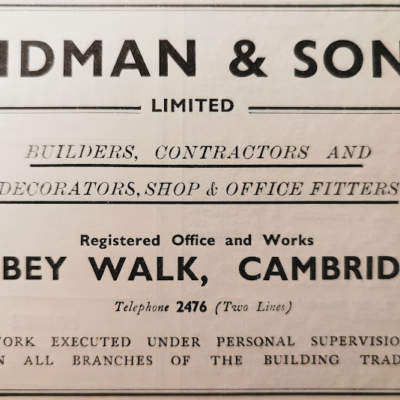Search by topic
- archaeology
- architecture
- bricklayer
- Building of Local Interest
- carpenter
- church
- crime
- dressmaker
- fire
- general labourer
- Great Eastern Railway
- listed building
- medieval
- oral history
- Public House
- Rattee & Kett
- Roman
- scholar
- school
- Then and Now
- tudor
- women
- work
- world war one
- world war two
Search by text
31 York Street
The History of the Pinney Family
1881
Charles Emmines, head, 30, 1851, tailor, Cambridge
Sophy Emmines, wife, 29, 1852, Chesterton, Cambridgeshire
William C. Emmines, son, 6, 1875, scholar, Leeds, Yorkshire
Ellen B. Emmines, daughter, 4, 1877, scholar, Chesterton, Cambridgeshire
Lucy Emmines, daughter, 3, 1878, scholar, Chesterton, Cambridgeshire
Charles H. Emmines, son, 2, 1879, Chesterton, Cambridgeshire
Alfred M. Emmines, son, 1 month, Cambridge
1889 – 1966
By 1889 the Pinney family are living at 31 York Street. Head of household is Cartwright Pinney, a 46 year old smith and boiler maker from Cambridge. Birth records show that his given name is Tobias Cartwright Pinney, however he uses Cartwright on the census records.
Cartwright is married to Susan (nee Peters), in 1881 she is 45 and the couple have five children. The eldest, George Ernest, is 15 and working as a blacksmith’s striker. Thomas Cartwright is 12, Florence Mary is 11 and Ruth Lillian is 5. Those three all attend school. The youngest child, Leonora Frances, is only 10 months old.
On the 22 December 1893, the Cambridge Independent Press reported that George Pinney of 31 York Street was summoned for assaulting Arthur Bennett on December 19th. George was sentenced to fourteen days hard labour.
George married Annie Hutton in 1895 and by 1901 is living at 14 York Terrace. He is employed as blacksmith’s labourer and a fitter for a cement company. Annie died in 1912, leaving George with eight children. By 1918 George and the children are living at 99 Ainsworth Street, George works at the the Atlas Stone Works on Coldham’s Lane.
Sadly, on the 1st July 1920, George has an accident at work and is killed when he lift he was repairing fell on him. The Cambridge Daily News reported on the accident and on his funeral.
Florence is working as a housemaid in an Insane Asylum in London by 1901. She married gas worker Henry John Scott in 1912. He was killed in action in World War 1 whilst serving with the 1st Wiltshire Regiment. Henry’s name is on the Cambridge Gas Workers Memorial on Newmarket Road.
The 1901 Census records that Cartwright is a blacksmith “on own account” and works from home. Thomas is 22 and no occupation has been recorded for him. Ruth is 15 and Leonora is 10.
Thomas married Louisa Fuller in 1902. They live at 29 Ainsworth Street until 1915. The 1939 Register shows them living at 4 York Street where Thomas is employed as a general labourer.
Cartwright died in 1904
Ruth married police constable Sidney George Hearn in 1908. They lived in Stoke Newington after their marriage, but by 1939 had moved back to Cambridge.
By the time of the 1911 Census, Susan Pinney is 65, and taking in laundry. Leonora (just called “Nora” on this census) is now 20 and working as a jam factory hand. Susan records that she was married for 45 years and had 12 children. Seven of those children are still living at the time of the 1911 Census.
Leonora married Arthur Hearn in 1915. By 1918 Arthur Hearn is registered at 31 York Street, so the couple were living with Susan until she died in 1930.
Cartwright and Susan are buried in Mill Road Cemetery.
Arthur died in 1950 and the Electoral Register shows that Leonora lived at 31 York Street until at least 1966. She died in 1976, aged 86.
Sources: 1881, 1891, 1901, 1911 UK Census, Mill Road Cemetery, Civil Registration Birth Index (1837-1915), Cambridge Daily News July 1920, Civil Registration Marriage Index (1837-1915), International War Museum, 1939 Register, Cambridge Independent Press 22 December 1893,
Contribute
Do you have any information about the people or places in this article? If so, then please let us know using the Contact page or by emailing capturingcambridge@
License
 This work is licensed under a Creative Commons Attribution-NonCommercial-ShareAlike 4.0 International License.
This work is licensed under a Creative Commons Attribution-NonCommercial-ShareAlike 4.0 International License.









